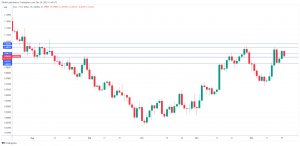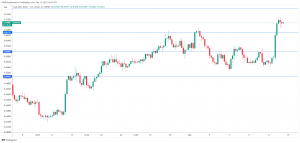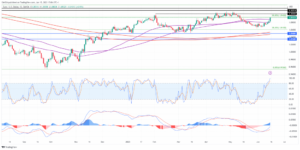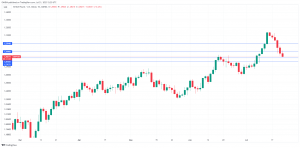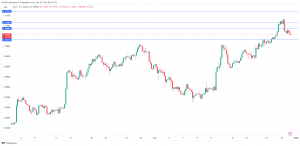Time for the Fed to step up
A blockbuster week in store in financial markets and one that begins with bank holiday’s across various countries. Throw in Chinese PMI data over the weekend and it could be a lively start to trading on Monday.
The standout event next week will naturally be the Federal Reserve monetary policy decision on Wednesday when we’re likely to see the first 50 basis point rate hike in more than 20 years. But does the central bank have a surprise up its sleeve after being unfashionably late to the party?
European energy markets will be another key focus next week with the EU reportedly close to agreeing on a Russian oil embargo. At the same time, the Kremlin is taking aim at “unfriendly countries” that refuse to pay for their gas in roubles. Which country will be next to be cut off?
Fed to intensify its tightening efforts
BoE expected to continue raising rates
RBA to finally join the tightening club?
US
The Fed is widely expected to follow through on delivering a faster pace or rate increases and announce the start of the reduction of their $9 trillion asset portfolio. This should not be a difficult meeting for Fed officials as the Fed has committed itself into delivering a string of rate hikes to finally fight inflation. The Fed knows its credibility is at stake and they will need to commit to a couple, maybe a few half-point rate increases before scaling down tightening to 25 basis point increases.
This will be a busy week filled with many major economic data releases, quarterly earnings reports, and Ohio holds a key US senate race to replace Senator Rob Portman who is set to retire. On Monday, the ISM Manufacturing report is expected to show factory activity posted a small rebound in April and Friday’s nonfarm payroll report to show slower job growth. The April non-farm payroll headline number is expected to decrease from 431,000 in March to 390,000 and the unemployment rate is expected to remain steady at 3.6%.
EU
There’s a huge focus on the EU energy market at the moment as a result of the standoff between Brussels and Moscow over natural gas. Poland and Bulgaria have already been cut off due to their refusal to abide by rouble demands. Other countries are less keen which is damaging the unity with which the bloc has punished Russia until now. That said, they are apparently close to agreeing on an oil embargo which will cut off a key source of funding for the Kremlin. How that’s implemented will be key. But all of this means higher energy prices, weaker economies and more pressure on the ECB to hike rates.
Next week offers a lot of economic data, the vast majority of which is tier two and three including final PMIs, unemployment and retail sales. ECB President Christine Lagarde will speak on Tuesday which will be closely followed for interest rate hints. Markets are pricing in multiple hikes this year now, a far cry from what the ECB signalled at the last meeting. June is now huge.
UK
The Bank of England is expected to continue the trend of a rate hike at every meeting with another 25 basis point increase next week. It appeared to be cooling its hawkish rhetoric last time around but given the inflation indicators since, I expect it to retain a hawkish stance on Thursday. Markets are pricing in six rate hikes this year, starting next week. The monetary policy report will accompany the decision with new projections and a press conference.
Rusia
The CBR cut interest rates to 14% on Friday (17% previously) and hinted at a more modest easing in future (Key Rate in 12.5-14% range). This came as it forecast growth to decline by 8-10% this year and inflation to hit 18-23% in 2022.
Next week offers the services and manufacturing PMIs which could provide further insight into the impact of the sanctions on the domestic economy. With an oil embargo potentially on the horizon and the Kremlin blocking exports of gas to countries unwilling to pay in roubles, further pain likely lies ahead.
Africa de Sud
Inflationary pressures are continuing to build, as evidenced in the PPI data last week. That will keep the pressure on the SARB to keep raising rates. Next week looks quiet, with the whole economy PMI the only notable release.
Turcia
Analysing Turkish inflation data has become a purely academic exercise in light of the CBRT’s decision to ignore it when making its policy decisions. It’s expected to hit 68% when the April data is released (CBRT expects it to peak at 70%) on Thursday and the PPI data may be even worse, having lept nearly 115% in March. CBRT Governor claimed developments show the rate cuts were the right decision. I’m not sure those impacted by them will agree.
China
Markets are heavily distorted in Asia this week due to a plethora of holidays. China is closed from Monday until Wednesday meaning any negative developments surrounding covid zero or other geopolitics will be reflected via the offshore USD/CNH and other regional stock markets such as Australia.
We have significant risk this weekend as China releases official manufacturing and non-manufacturing PMIs and the Caixin manufacturing PMI. All have downside risks and with most of Asia, including China and Hong Kong closed on Monday, USD/CNH has significant upside risk, following on from the demolition of the onshore and offshore Yuans versus the US Dollar this week.
China releases the Caixin non-manufacturing PMI on Thursday, the only other significant data release during the week. If there has been a lot of event risk passing through markets in the first few days of the week, China stock markets could gap quite a long way, up or down when they reopen Thursday, especially if the FOMC surprises in some way in the hours before.
India
The INR and Sensex have been resilient in the past week; perhaps benefitting from investor inflows leaving China. India is on holiday on Tuesday.
India releases manufacturing PMI and balance of trade on Monday, with non-manufacturing PMI on Thursday. Markets will be looking for a negative impact from India’s nationwide power shortages which could put short-term downward pressure on the Sensex and the INR.
Australia
Australia could be a correlation trade for the tier-1 PMI releases from China over the weekend. Poor China data could see the AUD and local equities pressured with most of Asia, ex-Japan closed. Similarly, a decent showing by the China PMIs will have a positive impact.
Piețele, în special piețele valutare, s-ar putea confrunta cu probleme de lichiditate și s-ar putea vedea mișcări bruște dacă știrile de weekend sunt grele, deoarece Australia și Japonia vor fi singurele două centre majore deschise.
Most attention will be focused on Tuesday’s RBA rate decision. A 0.15% hike is fully priced by markets and the clouds from Ukraine and China are weighing heavily on AUD/USD anyway. If the RBA does not hike AUD/USD could fall sharply in the short term. If the RBA hikes and adjusts its guidance to a more hawkish, AUD/USD could potentially see a big move higher.
Noua Zeelandă
NZD trading faces liquidity issues in the coming week with the majority of Asia on holiday for most of the week. It may move sharply on Monday as a China correlation trade if China’s weekend PMI data contains surprises. Otherwise, NZD/USD continues to underperform AUD/USD badly as markets continue pricing in an economic slowdown and an RBNZ far behind the inflation curve, forcing it to hike New Zealand into a recession.
New Zealand releases employment, participation, labour costs and the RBNZ Financial Stability Report on Wednesday. All present volatility risk. The RBNZ press conference midday will be monitored for a more hawkish outlook, especially if the labour cost index accelerates higher.
Japonia
Japan begins Golden Week and will be closed Tuesday through Thursday. USD/JPY has risen by over 200 points this week and may close above 130.00 this evening. With most of Asia on holiday Monday except Japan, that would be a perfect day for the MOF to conduct some subtle (or not) selling of USD/JPY into low liquidity conditions.
An unchanged BOJ has left the Yen at the mercy of the US/Japan interest rate differential and if US yields rise next week with Japan closed, USD/JPY has significant upside risks.
Singapore
Singapore is closed Monday and Tuesday. It releases the manufacturing PMI on Wednesday and retail sales on Thursday. Both have downside risks given the China slowdown and inflation eroding consumer confidence. That may force local equities lower, especially as all three heavyweight local banks reported 10% falls in Q1 profits this week.
Like the rest of Asia, the SGD remains under pressure due to a rampant US dollar. That may force the MAS into some buying of SGD to maintain its $NEER corridor with the central bank not due to adjust policy until October.
Calendar Economic
Sâmbătă, aprilie 30
Date economice / evenimente
China April Manufacturing PMI: 47.3 expected v 49.5 prior; Non-Manufacturing (Services): 46.0 expected v 48.4 prior; Caixin PMI data
Berkshire Hathaway reports Q1 earnings and Warren Buffett speaks at Berkshire Hathaway’s annual meeting
Duminica, Mai 1
Date economice / evenimente
Milken Institute Global Conference begins
Luni, Mai 2
Date economice / evenimente
Cheltuielile SUA pentru construcții, producția ISM
Eurozone Markit manufacturing PMI
France Markit manufacturing PMI
Germany Markit manufacturing PMI
Prețurile casei CoreLogic din Noua Zeelandă
Australia CoreLogic house prices, inflation gauge, commodity index, PMI
PMI de producție din India
Australia PMI de producție
Japan PMI, vehicle sales, consumer confidence index
Italia somaj
Coinbase CEO Armstrong speaks at Milken conference
Marți, 3
Date economice / evenimente
Reserve Bank of Australia (RBA) rate decision: Expected to raise Cash Rate Target 15bps to 0.25%
Încrederea consumatorilor din Australia
Eurozone PPI, unemployment
somaj in Germania
PIB-ul Hong Kong
Japan vehicle sales
Thailand business sentiment index, PMI
Rezervele internaționale din Mexic
Autorizațiile de construcție din Noua Zeelandă
South Korea CPI
U.K. Markit manufacturing PMI
U.S. factory orders, durable goods, light vehicle sales
Miercuri, Mai 4
Date economice / evenimente
FOMC decision: Expected to raise interest rates by a half-point and announce when they will be reducing their balance sheet
US trade data
Australia PMI, retail sales, home loans
Vânzări cu amănuntul în zona euro, PMI servicii Markit
Comerțul din Germania
RBNZ releases financial stability report
New Zealand unemployment, commodity prices
Singapore electronic sector index
Șomajul în Spania
Raportul de inventar al țițeiului EIA
Joi, Mai 5
Date economice / evenimente
SUA revendicări inițiale pentru ocuparea forței de muncă
BOE rate decision: expected to raise bank rate 25bps to 1.00%
China Caixin PMI composite, services
Franța producție industrială
Comenzile fabricii din Germania
Australia trade, building approvals
IPC din Thailanda
India PMI composite, services
Norway rate decision: Deposit rate expected to stay steady at 0.75%
Poland rate decision: Expected to raise rates 75 or 100bps.
Vânzări cu amănuntul din Singapore
OPEC+ regular meeting
Vineri, Mai 6
Date economice / evenimente:
US April Change in nonfarm payrolls: 390K expected v 431K prior: unemployment rate: 3.6% expected v 3.6% prior
Fed’s Waller and Bullard discuss monetary policy on a panel hosted by the Hoover Institution
Sweden’s Riksbank releases minutes from its April 27 meeting
BOE chief economist Pill speaks at a monetary policy report briefing
Șomajul din Canada
Germania producție industrială
Japonia Tokyo IPC, bază monetară
RBA statement of monetary policy
Australia Rezerve externe
PMI din Singapore
Thailand forward contracts
Spania producție industrială
Actualizări de rating suveran
Republica Cehă (Fitch)
Portugalia (Fitch)
Norvegia (Moody's)
- 000
- ani 20
- 2022
- peste
- activitate
- TOATE
- deja
- anunța
- anual
- O alta
- Aprilie
- Armstrong
- în jurul
- Asia
- activ
- Australia
- Bancă
- Bank of England
- Băncile
- bază
- deveni
- fiind
- Berkshire
- blockbuster
- Bruxelles
- construi
- Clădire
- Bulgaria
- afaceri
- Cumpărare
- Bani gheata
- Banca centrala
- CEO
- Schimbare
- şef
- China
- chinez
- închis
- club
- venire
- comise
- produs
- Conferință
- încredere
- construcţie
- consumator
- conține
- continua
- continuă
- Cheltuieli
- ar putea
- țări
- ţară
- Cuplu
- Covidien
- Monedă
- curba
- de date
- zi
- livrarea
- cererile
- evoluții
- dificil
- discuta
- Dolar
- jos
- Câștig
- easing
- BCE
- Economic
- economie
- ocuparea forţei de muncă
- energie
- Piața energiei
- Anglia
- mai ales
- EU
- eveniment
- Cu excepția
- Exercita
- aștepta
- de aşteptat
- se așteaptă
- Față
- fete
- fabrică
- mai repede
- fed-
- federal
- Federal Reserve
- În cele din urmă
- financiar
- First
- Concentra
- concentrat
- urma
- următor
- străin
- Înainte
- Vineri
- de finanțare
- mai mult
- viitor
- decalaj
- GAS
- Caritate
- bunuri
- Guvernator
- Creștere
- având în
- Categoria grea
- superior
- deține
- concediu
- Acasă
- Hong Kong
- orizont
- găzduit
- casă
- Cum
- HTTPS
- mare
- Impactul
- implementat
- Inclusiv
- Crește
- index
- India
- industrial
- inflaţiei
- interes
- Ratele dobânzilor
- Internațional
- inventar
- investitor
- probleme de
- IT
- în sine
- Japonia
- Loc de munca
- alătura
- Cheie
- Coreea
- Muncii
- ușoară
- Probabil
- Lichiditate
- local
- Lung
- cautati
- menține
- major
- Majoritate
- Efectuarea
- de fabricaţie
- Martie
- Piață
- pieţe
- MAI MULT
- sens
- Reuniunea
- luni
- Monetar
- mai mult
- Moscova
- cele mai multe
- muta
- multiplu
- Natural
- Gaz natural
- negativ
- Noua Zeelandă
- ştiri
- număr
- promoții
- oficial
- Ohio
- Ulei
- deschide
- comenzilor
- Altele
- in caz contrar
- Perspectivă
- Durere
- participare
- Care trece
- Plătește
- Perfect
- poate
- Punct
- puncte
- Polonia
- Politica
- sărac
- portofoliu
- pozitiv
- putere
- prezenta
- preşedinte
- presa
- presiune
- de stabilire a prețurilor
- profiturile
- proiecţiile
- furniza
- Q1
- Rasă
- ridica
- gamă
- tarife
- evaluare
- RE
- recesiune
- reducerea
- regional
- regulat
- eliberaţi
- eliberat
- Lansări
- raportează
- Rapoarte
- Republică
- REST
- cu amănuntul
- Risc
- Riscurile
- Rusia
- Said
- de vânzări
- sancţiuni
- scalare
- sector
- Senat
- Senator
- sentiment
- Servicii
- set
- Pantaloni scurți
- Pe termen scurt
- penuriei
- semnificativ
- asemănător
- SIX
- mic
- unele
- vorbeşte
- Cheltuire
- Stabilitate
- miză
- Începe
- Declarație
- şedere
- stoc
- Piețele de acțiuni
- stoca
- surpriză
- luare
- Ţintă
- Prin
- timp
- Tokyo
- comerţului
- Trading
- stare de nervozitate
- Uk
- Ucraina
- șomaj
- unitate
- us
- Dolar american
- Senatul SUA
- diverse
- vehicul
- Impotriva
- Volatilitate
- crescătorie de iepuri de casă
- Warren Buffett
- miercuri
- săptămână
- weekend
- Ce
- OMS
- Fire de sârmă
- ar
- an
- ani
- Yen
- zero




